Most commercially-made hot sauces are heavily laden with salt. Or have so much vinegar in them, that that is all you can taste. A cynic might say that commercial makers overload with cheaper ingredients to make up for a lack of decent peppers in the sauce!
This recipe is just pure flavour and heat. It comes sugar and salt free straight out of the book, to deliver your mouth fiery pleasure for just 8 calories and 2 mg sodium per tablespoon (15 ml). Look at the nutrition label on that last jar of hot sauce you bought and see how it measures up.
The recipe makes a lot; you may wish to cut the recipe in half.
This makes a quite hot, thick, spoonable hot sauce to be used as a condiment. For a less-hot, pourable hot sauce see Easy Hot Sauce. (It also requires fewer hot peppers.)
See other hot sauces.
The recipe
Jar size choices: Either 125 ml (½ cup / 4 oz) OR ¼ litre (½ US pint / 8 oz) OR ½ litre (1 US pint / 500 ml/ 16 oz)
Processing method: Either water-bath or steam canning
Yield: 5 x ½ litre (US pint) jars
Headspace: 2 cm (½ inch)
Processing time: Either size jar 10 minutes
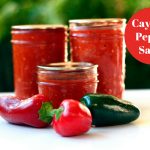
Cayenne pepper sauce
Ingredients
- 2 litres tomatoes (diced, canned. 3 x 700 ml / 28 oz cans)
- 1.25 kg peppers (hot. 2 ¾ lbs. Measurements after prep.)
- 500 g onion (sliced. 4 cups, sliced. 1 lb. Measurements after prep.)
- 75 g garlic (minced. ⅓ cup / 2.5 oz)
- 50 g coriander (aka cilantro. Fresh chopped leaves. About 5 tablespoons / ⅓ cup)
- 750 ml cider vinegar (5 % or higher. 3 cups / 24 oz)
- 600 ml water (2 ½ cups / 20 oz)
Instructions
- Empty tomatoes into a pot about 10 litres / quarts in size or larger. You can start warming the pot slowly.
- Wash the peppers, stem them, but leave seeds in.
- Slice peppers into rings or whiz coarsely in food processor. Add to pot.
- Wash and peel the onions, then cut into slices. Add to pot.
- Wash, peel and mince the garlic, add to pot.
- Wash and chop the coriander. Add to the pot.
- Add the apple cider vinegar and the water.
- Crank heat on pot and bring to a boil.
- Boil steadily, though not crazily, uncovered for an hour. Stir periodically.
- After that hour, lower heat to a simmer and let cook uncovered for another additional hour. Stir periodically.
- Turn stove burner off. Remove from heat and let cool a bit so that it's safe for the next step.
- (At this point, you could even refrigerate the mixture in tubs overnight and pick up the next day.)
- Put mixture through a blender in small batches, blending each one for about 2 minutes per batch so that it's a totally smooth puréed sauce.
- When blended mixture is all back in the pot, crank the heat to bring it all back to a boil. Stir constantly but mind hot splattering of the sauce.
- When it's bubbling hot, turn off heat.
- Ladle hot sauce into heated jars, leaving 2 cm (½ inch) headspace.
- Debubble, adjust headspace.
- Wipe jar rims.
- Put lids on.
- Process in a water bath or steam canner.
- Process jars for 10 minutes; increase time as needed for your altitude.
Nutrition
Reference information
How to water bath process.
How to steam can.
When water-bath canning or steam canning, you must adjust the processing time for your altitude.
Australia and New Zealand vinegar strength special notes.
Recipe notes
- You need to start out with about 1.35 kg (3 lbs) of pepper before prep, with stems still on.
- Do wear plastic or rubber gloves for this. In this instance it is not wimpy to do so. It will seriously burn the skin on your hands otherwise, and if you touched your face or eyes could cause pain.
- Yes, leave the seeds in. At the very end, the blender will purée them all and they won’t be visible. A lot of heat is in the seeds.
- How hot a pepper you use is up to you. The recipe suggests Anaheim, Hungarian, Jalapenos, etc. They don’t all need to be the same colour, or pepper variety even. A blend can add to complexity of flavour.
- It really doesn’t matter how precisely you chop everything: it all gets whizzed to a smooth sauce at the end, anyway.
- Instead of fresh garlic you can use store-bought minced garlic from an oil-free jar as a time saver.
- Yes, put all three cans of tomatoes in. It doesn’t matter if you are a few ml / oz over or under.
- It might be an idea to plan to give your blender a bit of break every two to three batches so that you don’t overheat the motor.
- If you did store the cooked mixture overnight in the fridge, blend the mixture cold from the fridge, zap each blended batch for 3 minutes after that in microwave, then add to pot for overall reheating.
The National Center for Home Food Preservation rarely adds commentary to USDA or So Easy to Preserve recipes, but they do for this one, presumably owing to people misunderstanding just how hot a sauce this makes. They write:
This is a very hot sauce. Some suggested uses include:
- Add a small amount to a soup to give it a “spicy-hot” bite.
- Stir a small amount into vegetable dishes to give them an extra “zing.”
- Pep up your cheese dip with a small amount to make it a “hot” item.
- Add some to that pot of chili you’re cooking up – make it fiery!
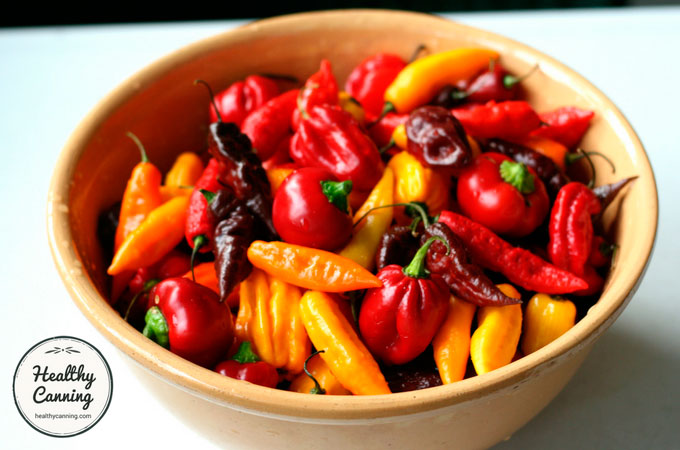
Mixture pictured: Fresno Serena, Morelia Red and Yellow, Toluca Red, Yellow Pencil Hots, Habeneros Red and Brown, Ghost (Naga Red).
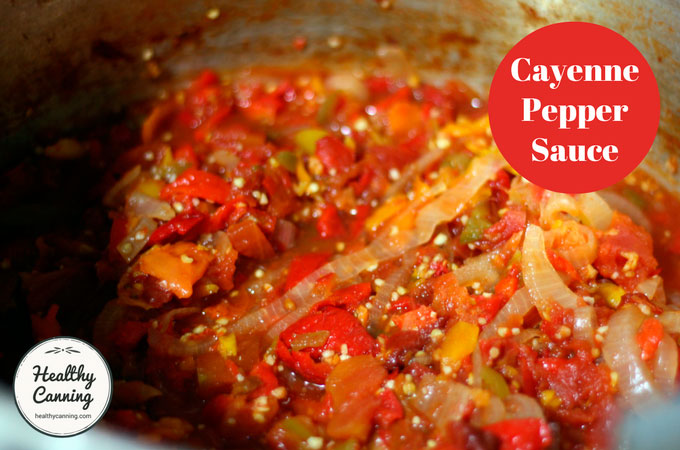
The mixture after two hours of cooking, boiled down and ready for the blender.
Recipe source
- Cayenne Pepper Sauce. In: Andress, Elizabeth L. and Judy A. Harrison. So Easy to Preserve. University of Georgia Cooperative Extension. Bulletin 989. Sixth Edition. 2014. Page 67.
- Also appears in: United States Department of Agriculture (USDA). Complete guide to home canning. Agriculture information bulletin No. 539. 2015. Page 3-17. (Also: Cayenne Sauce on National Center site.)
Modifications made:
- none
Safety Check
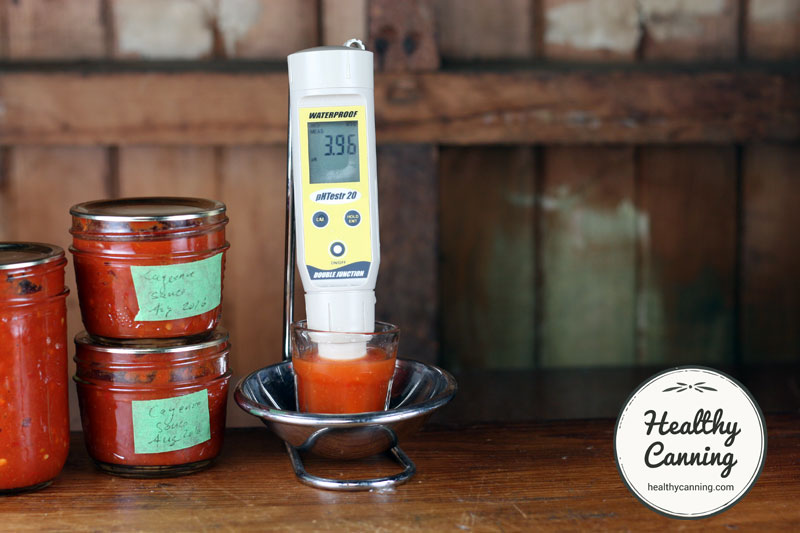
This Cayenne Pepper Sauce had a pH of 3.96, measured after 3 months. pH will vary of course based on pepper variety used, where grown, growing conditions, etc.
Green hot sauce variation
- In place of the canned tomatoes, use the same volume of canned tomatillos;
- For the peppers, use green jalapenos and / or other green hot peppers;
- In place of the 3 cups (750 ml) of apple cider vinegar, use 2 cups (500 ml) apple cider vinegar and 1 cup (250 ml) bottled lime juice.
Follow recipe otherwise exactly. Beware of scorching at the bottom of the pot simmering when using tomatillos: stir frequently or use a heat diffuser.
This variation is safe because the acidity safety levels have been kept (in fact, they have been enhanced):
- Tomatillos are more acidic than tomatoes;
- All peppers are treated the same when it comes to acidity;
- Bottled lime juice is more acidic than apple cider vinegar (but using more than 1 cup of lime juice might overwhelm the taste.)
Nutrition information
Per tablespoon:
- 8 calories, 2 mg sodium
* Nutrition info provided by https://caloriecount.about.com
* PointsPlus™ calculated by healthycanning.com. Not endorsed by Weight Watchers® International, Inc, which is the owner of the PointsPlus® registered trademark.

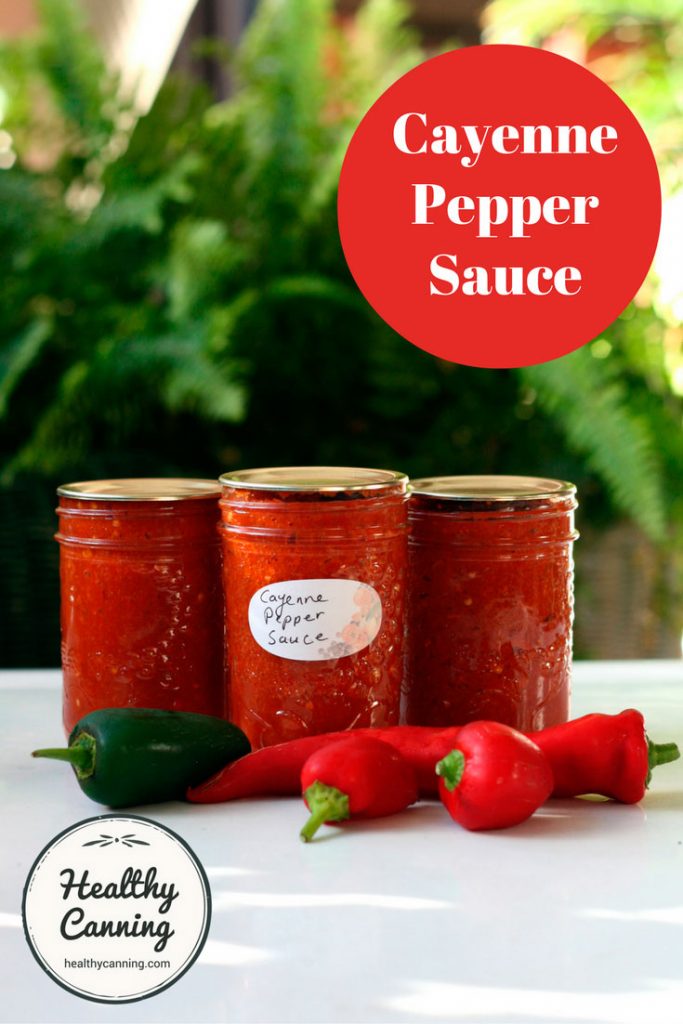
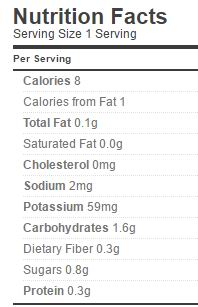
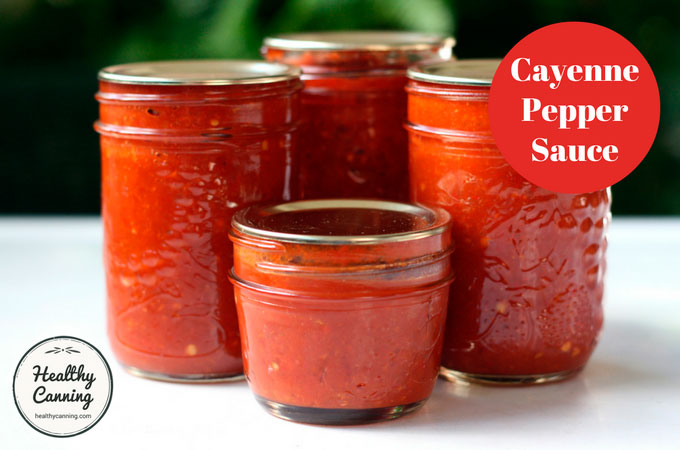
Karen
Once opened, can this be left out on the table (like Tabasco), or would it need to be refrigerated? Thank you!
Healthy Canning
Refrigerate after opening.
Pia
Can I add salt to this recipe?
Thanks!
Healthy Canning
Yes, you may. Salt is a dry seasoning, and it’s fine to adjust dry seasonings in canning recipes. See Tweaking Canning Recipes.
Pia
Thanks so much! I added a bit of salt and it’s perfect. This is such a delicious sauce!
Mike
Do the ingredients separate over time after jarred?
Healthy Canning
We have never known them to in this recipe, but if they did, just shake to recombine.
Crystal
I love your site, have bookmarked it as a wonderful resource and will be telling all my canning friends to check it out.
One question, if I pressure can or water bath hot sauce, can I leave it on the pantry shelf, and for how long?
thank you
Healthy Canning
I only know of one “hot sauce” recipe that calls for pressure canning: https://nchfp.uga.edu/how/can_salsa/mexican_tomato_sauce.html but it’s more of a sauce with some heat to it, than a hot sauce. All others call for water-bathing canning. I’d encourage you to be sure to find and use a tested recipe, rather than one you make it, to ensure that it has the proper acidity to make it safe for shelf stable canning. There are many. Freeze your own concoctions for long-term storage. The recommendation for storage is that, for peak quality, use items within a year. After that point in time, depending on how good the storage conditions are, and on the particular item, quality may slowly start to decline. https://www.healthycanning.com/the-shelf-life-of-home-canned-goods/
Natalie Chandler
Could you use fresh tomatoes in this instead of canned?
Healthy Canning
You would just need to use those fresh tomato to make crushed tomato first. On average, as a very rough guideline, for fresh tomatoes expect to need about 1 kg per 1 litre jar (2 1/4 to 2 3/4 lbs per US quart jar) of crushed tomato.